Introduction
Romanticism is a philosophical movement of the nineteenth century which had a profound influence on music which can still be seen right up to today. Its main characteristics in music are the emphasis on the personal, dramatic contrasts, emotional excess, a focus on the nocturnal, the ghostly and the frightful, spontaneity, and extreme subjectivism. Romanticism in culture implied a turning inward and encouraged introspection. As Hegel wrote:
“The entire content [of romantic art] is therefore concentrated on the inner life of the spirit”.Romanticist-influenced music increased its audience dramatically from the early theatres of the nineteenth century to the mass pop concerts of the modern era. Romanticism changed music from being a progressive force in society to being a narcotic and self indulgent individualist experience. In modern times it has been industrialised and commercialised and sells individualism and political impotence to the very people who turn to it for solace from desperation in a highly alienated society.
The most regrettable aspect of this alienation is that music has become more and more distant from people’s movements for progressive change. In the past, progressive music, i.e. music which was in tune with the history of people’s political struggles, tended to come from the people themselves, in the form of ballads or music from progressive composers and lyricists. With the commercialising of the pop music industry in the twentieth century, music moved from something to be consumed on a mass basis rather than produced by people on a local basis – by writing, playing or singing, as it was in the past with balladeers, choirs and progressive composers.
Here we will look at the influence of Romanticism on music from the Classical period in the eighteenth and nineteenth centuries through to the development of the pop music industry in the twentieth century. Also examined will be composers and singers who resisted the pressure of the Romantic influence and wrote and played music that was rooted in hardship and struggle and an awareness of international issues and crises as they affected the ordinary people of those countries.
Classical Music – ‘structures should be well-founded’
While classical music in general has a broad meaning the Classical period was an era of classical music between roughly 1730 and 1820. Enlightenment respect for the politics, aesthetics and philosophy of classical antiquity (Classicism) combined with the development of ‘natural philosophy’ – the precursor of the natural sciences – had a profound effect on music: “Newton’s physics was taken as a paradigm: structures should be well-founded in axioms and be both well-articulated and orderly.” The effect of Enlightenment ideas on Classical music was to mark a change to a lighter, clearer texture compared with the Baroque music that came before it.
Thus the findings in science broadly affected or influenced culture in general. At the same time technical developments in musical instruments and the increase in size and standardisation of orchestras changed the way music was played. The major composers of this time were Wolfgang Amadeus Mozart, Ludwig van Beethoven, Joseph Haydn, Christoph Willibald Gluck, Johann Christian Bach, Luigi Boccherini, Carl Philipp Emanuel Bach, Muzio Clementi, Antonio Salieri, and Johann Nepomuk Hummel.
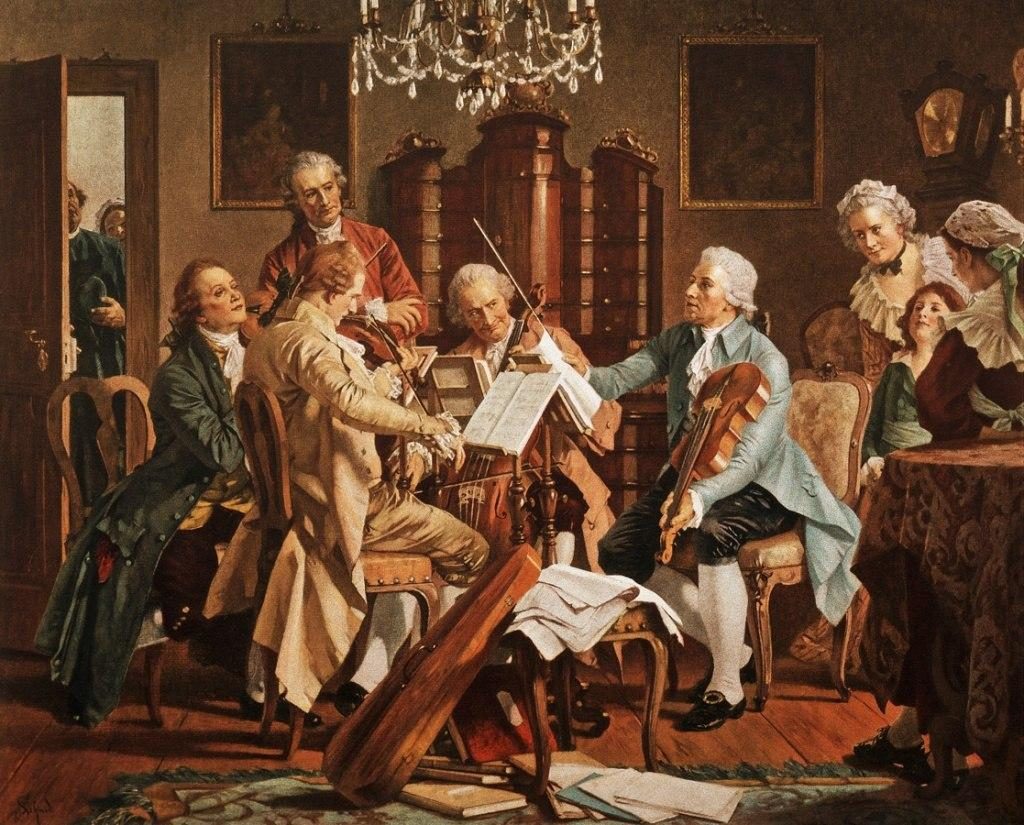
Joseph Haydn Playing Quartets
Romantic Music – ‘more explicitly expressive and programmatic’
Romanticism originated at the end to the 18th century mainly as a reaction to the Age of Enlightenment and the Industrial Revolution which were perceived to be using science to destroy nature and man’s traditional way of life. The Romantic emphasis on feeling was in direct contrast with Enlightenment ideas of progress with reason and science being the primary source of knowledge. The philosophers and scientists of the Enlightenment had desired to move away from the Feudalism and Scholasticism of the religiously dominated Middle Ages. Unfortunately, the Romantic artists, composers and poets took a new interest in aspects of medievalism that the Enlightenment philosophers had tried to defeat. Enlightenment ideas were also taken up by the new elites who used science in the exploititive ways so hated by the Romantics.
However, despite the impression one might get from the Romantics
emphasis on emotion, Enlightenment ideas were not devoid of feeling.
Anthony Ashley Cooper, 3rd Earl of Shaftesbury
(1671 – 1713) believed that all human beings had a ‘natural affection’
or natural sociability which bound them together. Francis Hutcheson (1694 – 1746) wrote that “All Men have the same Affections and Senses” while David Hume(1711
– 1776) believed that human beings extend their “imaginative
identification with the feelings of others” when it is required.
Similarly, Adam Smith (1723 – 1790), the writer of Wealth of Nations, believed in the power of the imagination to inform us and help us understand the suffering of others. [1]
The Romantic reaction towards Classicical music and the ideals of the Enlightenment in one sense was not surprising given the failure of those ideas ultimately in the French Revolution. As Friedrich Engels wrote in Anti-Dühring in 1877:
In general, Romantic music was “more explicitly expressive and programmatic” and public concerts were held for the urban middle class compared to earlier periods when they were mainly the domain of aristocrats. The string section was enlarged and the piano took over from the harpsichord as an accompaniment to songs (lieder) such as Schubert’s Winter Journey. The main composers in the Romantic style were Schubert, Brahms, Berlioz, Tchaikovsky, Mendelssohn, Dvorak, Chopin, Grieg, Schumann, Rimsky-Korsakov, Liszt, Elgar and Wagner.
Many of these composers were also associated with that great combination of Romanticism and politics – Nationalism – and composed music using folk tunes, dance rhythms and local legends for this purpose. As nationalist leaders developed ideas of race and a unified nation (often based on territories containing many different ethnic and cultural groups) composers created the musical soundtrack to the burgeoning centralisation and homogenisation of modern states. One of the most negative aspects of nationalist political structures was the First World War, where the peoples of these relatively new states were set against each other in the style of the earlier feudal monarchies: in the interests solely of their leaders.
Hanns Eisler – ‘One cannot always write optimistic songs’
While Romanticism reached its peak during the period of 1800 to 1850, its influence continued on throughout the twentieth century. Hanns Eisler (1898-1962) was an Austrian composer who fought in a Hungarian regiment during the First World War, resisted the debilitating effects of Romanticism in his music. After the war he became more and more radicalised and threw himself into the class politics of the day. Eisler had a long artistic association with Bertolt Brecht:
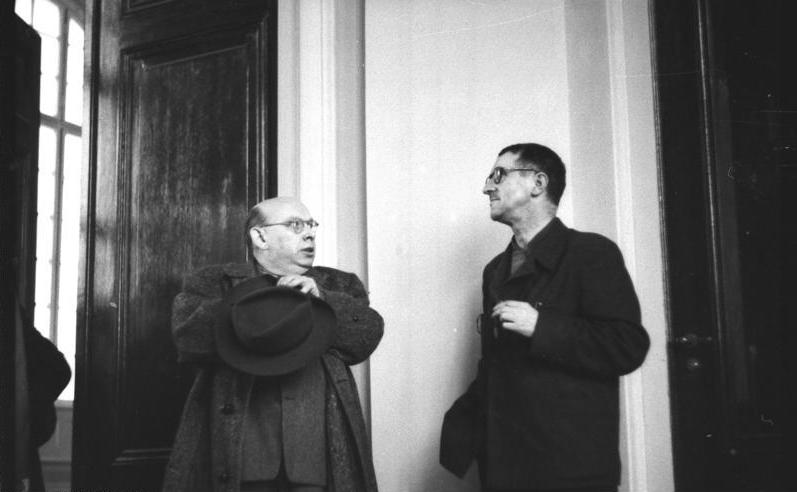
Hanns Eisler (left) and Bertolt Brecht, his close friend and collaborator, East Berlin, 1950.
The Romantic reaction towards Classicical music and the ideals of the Enlightenment in one sense was not surprising given the failure of those ideas ultimately in the French Revolution. As Friedrich Engels wrote in Anti-Dühring in 1877:
“the French philosophers of the eighteenth century, the forerunners of the Revolution, appealed to reason as the sole judge of all that is. A rational government, rational society, were to be founded; everything that ran counter to eternal reason was to be remorselessly done away with. We saw also that this eternal reason was in reality nothing but the idealised understanding of the eighteenth century citizen, just then evolving into the bourgeois. The French Revolution had realised this rational society and government. But, the new order of things, rational enough as compared with earlier conditions, turned out to be by no means absolutely rational. The state based upon reason completely collapsed.”As Engels notes this resulted in the Reign of Terror and then Napoleonic despotism. The ideals of the Enlightenment philosophers were destroyed by an intensification of competition. He writes:
“The promised eternal peace was turned into an endless war of conquest. The society based upon reason had fared no better. The antagonism between rich and poor, instead of dissolving into general prosperity, had become intensified by the removal of the guild and other privileges, which had to some extent bridged it over, and by the removal of the charitable institutions of the Church. The development of industry upon a capitalistic basis made poverty and misery of the working masses conditions of existence of society.”How is it then that it is the Romantics that are more associated with the revolutionary ideas of the time? Why were they seen by critics and historians as reactionary or politically irrelevant? According to Max Blechman in Revolutionary Romanticism:
“The early romantics were revolutionaries: not because they believed in a political insurrection in their homeland […] but because through public expression they hoped to redefine the meaning of progress and revolutionize the values of modern civilisation.” […] Romanticism in Germany (as in France and England) was a protean [ever changing] movement, and the writings of formative romantics were contradicted by those of late romantics, some of whom broke with the early romantics’ idealism for various forms of conservatism.” [2]The Romantics, instead of questioning the class basis of society which was becoming more and more sharply delineated, reached back to the simpler life, religiosity and culture of the Middle Ages. The idea of chivalrous heroes, the mystic and supernatural, untouched nature and the security of spiritual beliefs formed the basis of a new culture of individuals and heroes battling against crass modernity. Romantic composers put much more emphasis on showing their innermost thoughts and feelings about love, hate and death through powerful expressions of emotion. Romantic music developed “the use of new or previously not so common musical structures like the song cycle, nocturne, concert etude, arabesque and rhapsody, alongside the traditional classical genres.”
In general, Romantic music was “more explicitly expressive and programmatic” and public concerts were held for the urban middle class compared to earlier periods when they were mainly the domain of aristocrats. The string section was enlarged and the piano took over from the harpsichord as an accompaniment to songs (lieder) such as Schubert’s Winter Journey. The main composers in the Romantic style were Schubert, Brahms, Berlioz, Tchaikovsky, Mendelssohn, Dvorak, Chopin, Grieg, Schumann, Rimsky-Korsakov, Liszt, Elgar and Wagner.
Many of these composers were also associated with that great combination of Romanticism and politics – Nationalism – and composed music using folk tunes, dance rhythms and local legends for this purpose. As nationalist leaders developed ideas of race and a unified nation (often based on territories containing many different ethnic and cultural groups) composers created the musical soundtrack to the burgeoning centralisation and homogenisation of modern states. One of the most negative aspects of nationalist political structures was the First World War, where the peoples of these relatively new states were set against each other in the style of the earlier feudal monarchies: in the interests solely of their leaders.
Hanns Eisler – ‘One cannot always write optimistic songs’
While Romanticism reached its peak during the period of 1800 to 1850, its influence continued on throughout the twentieth century. Hanns Eisler (1898-1962) was an Austrian composer who fought in a Hungarian regiment during the First World War, resisted the debilitating effects of Romanticism in his music. After the war he became more and more radicalised and threw himself into the class politics of the day. Eisler had a long artistic association with Bertolt Brecht:
“Eisler wrote music for several Brecht plays, including The Decision (Die Maßnahme) (1930), The Mother (1932) and Schweik in the Second World War (1957). They also collaborated on protest songs that celebrated, and contributed to, the political turmoil of Weimar Germany in the early 1930s. Their Solidarity Song became a popular militant anthem sung in street protests and public meetings throughout Europe, and their Ballad of Paragraph 218 was the world’s first song protesting laws against abortion. Brecht-Eisler songs of this period tended to look at life from “below” — from the perspective of prostitutes, hustlers, the unemployed and the working poor. In 1931–32 he collaborated with Brecht and director Slatan Dudow on the working-class film Kuhle Wampe.”

Hanns Eisler (left) and Bertolt Brecht, his close friend and collaborator, East Berlin, 1950.
Eisler’s connection with the class politics and struggles of the people are demonstrated in his awareness of the problems of composing in difficult times. He stated: “It is: consciousness-reflection-depression-revival-and again consciousness … It must be done that way, otherwise it is not good. One cannot always write optimistic songs … one must describe the up and down of actual situations, sing about it and comment on it.” [3] The dialectics of the process of consciousness and reflection helped him to work with ideas that are sorrowful without falling into a state of resignation. In one of his song series ‘Ernste Gesänge’ for baritone solo and string orchestra, Albrecht Betz notes:
Similarly, in music practice, Eisler also avoided the Romantic element: “I am always horrified to hear a group of union workers, toughened by many class struggles singing, “La, la, la, la, la, la, laaaa, aaaa,” or “I am so lonesome when I remember you.” [5] Eisler and Brecht had a lot in common. Both had “an anti-romantic attitude” and “a rejection of the psychological and the autobiographical”. Betz writes:“The third song, ‘Verweiflung’ [Despair], is a fragment from Leopardi’s famous poem ‘A se stesso’; Eisler has condensed it and freed it of all its features of Romantic discontent. Sorrow, as well as occasional anger, is sublimated in the composition’.” [4]
Woody Guthrie – ‘This Machine Kills Fascists’“Both had in view the ‘avoidance of the narcotic effects’ of art, the aim to conduct experiments so as to bring it to the height of rationality which would correspond to the scientific age in which they lived, and above all to arm it with a theory which would rationalize the functions of this art.” [6]
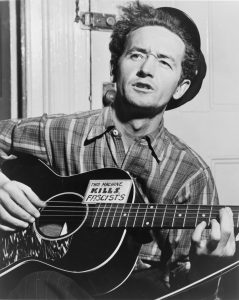
Guthrie with guitar labeled “This machine kills fascists” in 1943.
Another singer songwriter who would also avoid the ‘narcotic effects’ of music was Woody Guthrie (1912 – 1967). Brought up in Oklahoma, USA, Woodrow Wilson Guthrie was an American singer-songwriter, one of the most significant figures in American folk music. Guthrie wrote hundreds of political, folk, and children’s songs, along with ballads and improvised works. One of his most famous songs “This Land Is Your Land” was inspired by his reaction to Irving Berlin’s “God Bless America” on the radio.
Guthrie experienced hardship at first hand when he joined the thousands of migrants going to California to look for work during the Dust Bowl period. He became concerned by the conditions of life endured by working-class people and started writing songs about unemployment, migration, trade unions, labour struggles, and anti-fascist songs. All his life he believed in the power of music to change society and people’s attitudes. He performed regularly and wrote thousands of songs, poems and prose reflecting the life of working class people, neatly summing it up in the terse statement: “All you can write is what you see.”
Nueva Canción – ‘oppositional in every respect’
By the 1960s, a counterculture movement was making inroads into popular culture with movements like Nueva Canción (New Song) in Argentina, Chile and Spain, the General Strike centered in Paris in May 1968 in France as well as the Civil Rights Movement in the USA. The Nueva Canción (NC) movement started in Chile and soon spread all over Latin America. It went through three main phases in Chile: “The first was one of protest, the second of direct political engagement and the third moved away from direct political engagement to focus on glorifying and documenting the life of working people.” On a formal level Nueva Canción used “non-mainstream musical devices in their compositions such as traditional styles, and their rhythmic patterns, harmonic progressions and scales associated with folkloric music as well as Andean instruments in their arrangements. The songs were thus oppositional in every respect to the new ‘invading’ culture and embodied in sound and content something fresh but at the same time familiar which seemed to appeal to a mass of Chileans.”
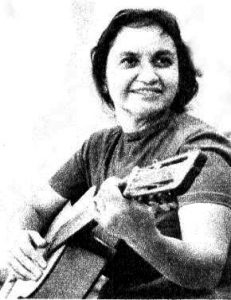
Violeta Parra in the 1960s
Composers like Violeta Parra (1917 – 1967) [also songwriter, folklorist, ethnomusicologist and visual artist] and Argentine singer, songwriter, guitarist, and writer, Atahualpa Yupanqui (1908 – 1992) were two of the most important and influential figures in the Nueva Canción popular musical movement which “was anti-imperial in its stance against commercialised American and European music while its content covered many issues associated with the peoples of the region such as “poverty, empowerment, imperialism, democracy, human rights, religion, and the Latin American identity”.”
They led a movement which was anti-Romantic in that they fought back against the narcotic effects of individualist, self-absorbed, introspective music and instead they encouraged a turning outward, an openness and interest in society and their position in that society, a positive attitude towards how society could be changed for the better.
Jazz, Pop and Rock – ‘part of the entertainment industry’
Earlier in the twentieth century jazz had been a popular form of music among the oppressed but it to fell victim to commercialisation. As Tim Blanning says:
“From the time it emerged toward the end of the nineteenth century,
jazz fit very well with the Romantic aesthetic,for it was nothing if
not spontaneous, improvisatory and individual. Its African-American
origins also made it the potential ally of liberation movements. During
much of the twentieth century, however, for all of jazz’s ability to
express the suffering and aspirations of an oppressed community, the
genre was very much part of the entertainment industry.” [7]
During the early 1960s the Beatles continued a rock and roll lively, dancing style developed by singers like Bill Haley and Elvis Presley. However, by the late 1960s, under the influence of the burgeoning drug culture, the tone changed and Romanticism gained the upper hand. Their music became “a music of introspective self-absorption, a medium fit for communicating autobiographical intimacies, political discontents, spiritual elevation, inviting an audience, not to dance, but to listen-quietly, attentively, thoughtfully’.” [8]
While the Vietnam war was the basis of many radical outpourings during the late 1960s and had even influenced the pop music industry charts, by the 1970s the entertainment industry had recovered to produce some of the most ‘tune in and drop out’ music ever produced by prog rock bands such as Pink Floyd, Genesis, Led Zeppelin etc. During the 1970s, artists like David Bowie and Eric Clapton overreached, when Bowie gave a ‘Nazi salute’ in London and Clapton stated that Britain was becoming a ‘black colony’ at a concert in Birmingham, both in 1976.
Indeed, in relation to Clapton, Blanning argues:
Fear, loneliness and anger became mainstays of Romanticism in the pop music of the 1970s and 1980s music with Punk (‘anger is an energy’), Morrissey (‘the pope of mope’) and U2 (‘I Still Haven’t Found What I’m Looking For’), not to mention the New Romantics and Heavy Metal. In more recent years, U2’s albums Songs of Innocence and Songs of Experience directly reference William Blake’s illustrated collection of poems of the same name. Blake was an English poet, painter, and printmaker who is considered a seminal figure in the history of the poetry and visual arts of the Romantic Age. Blake held visionary religious beliefs and opposed the Newtonian view of the universe. [10]“Arguably the greatest living master of the electric guitar, Clapton personified the Romantic aesthetic: ‘The classic Clapton pose-back to the crowd, head bowed over his instrument, alone with the agony of the blues-suggests a supplicant communing with something inward: a muse or a demon … his entire career can be seen as a search for a form in which he could express the staple blues emotions-fear, loneliness, anger and humour- in a personally valid way’.” [9]
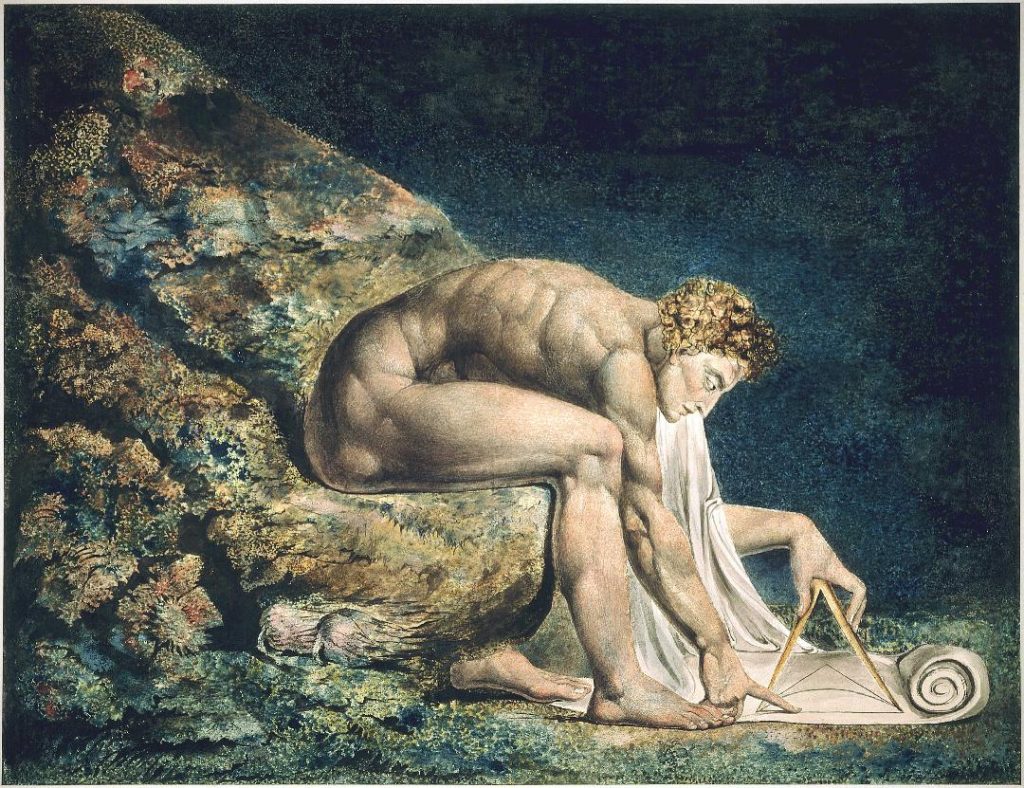
Blake’s
Newton (1795) demonstrates his opposition to the “single-vision” of
scientific materialism: Newton fixes his eye on a compass (recalling
Proverbs 8:27, an important passage for Milton) to write upon a scroll
that seems to project from his own head.
Johann Wolfgang von Goethe (1749 – 1832), the German writer famous for the novel The Sorrows of Young Werther (1774) is considered to have been one of the originators of the Romantic movement but in later life he described Romanticism as a ‘disease’. [11] The effect of the Romantic ‘disease’ on music has been to turn it inward and and convert its listeners into modern lotus eaters. In The Odyssey, Book IX, Odysseus is blown off course but reaches a land inhabited by people who live on a food that comes from a kind of flower. He sends a few men to investigate but upon tasting the lotus they fall into a peaceful apathy and lose interest in going home until Odysseus drags them out and leaves at once. Similarly much modern music has a narcotic effect on mass audiences who are overwhelmed by emotion while at the same time attain personal catharsis. [12]

Conclusion
The current geopolitical crises involving Venezuela, Syria, Yemen, Iran, Palestine and China are in need of mass political campaigns to bring about awareness and pressure against the drumbeats of a third world war. Building collectivist movements with a radical collectivist culture and moving away from the individualism and irrationalism of Romantic culture of the nineteenth and twentieth century is a necessary step towards real political change. Music, of all the arts, can be a powerful force in the creation of a collective consciousness. Composers of music and song highlighting the various issues affecting people today are necessary. Therefore, examining the issues around the form and content of music in society is an urgent requirement if music is to have an important cultural role in the future.
*
Note to readers: please click the share
buttons above or below. Forward this article to your email lists.
Crosspost on your blog site, internet forums. etc.
Notes
[1] The Enlightenment: And Why it Still Matters by Anthony Pagden (Oxford Uni Press, 2015) p72/3
[2] Revolutionary Romanticism: A Drunken Boat Anthology by Max Blechman (City Lights Books, 1999) p5
[3] Hanns Eisler Vokalsinfonik – Vocal Symphonic Music Berlin Classics CD, Sleeve notes p24
[4] Hanns Eisler Political Musician by Albrecht Betz [Trans Bill Hopkins] (Cambridge Uni Press: Cambridge, 1982) p235/7
[5] Hanns
Eisler: A Rebel in Music: Selected Writings by Hanns Eisler (Author), M.
Grabs (Editor) (Kahn and Averill, London, 1999) p143
[6] Hanns Eisler Political Musician by Albrecht Betz [Trans Bill Hopkins] (Cambridge Uni Press: Cambridge, 1982) p92
[7] The
Triumph of Music: Composers, Musicians and Their Audiences, 1700 to the
Present by Tim Blanning (Penguin Modern Classics, 2008) p114
[8] The
Triumph of Music: Composers, Musicians and Their Audiences, 1700 to the
Present by Tim Blanning (Penguin Modern Classics, 2008) p121
[9] The
Triumph of Music: Composers, Musicians and Their Audiences, 1700 to the
Present by Tim Blanning (Penguin Modern Classics, 2008) p118/9
[10] The Romantic Rebellion: Romantic Versus Classic Art Illustrated by Sir Kenneth Clark (John Murray Pub., 1973) p167
[11] The Roots of Romanticism by Isaiah Berlin (Princeton Uni Press, 1999) p130
[12] Homer The Odyssey (Penguin Classics, 1988) p141
All images in this article are from Wikimedia
Caoimhghin Ó Croidheáin is an Irish artist, lecturer and writer. His artwork
consists of paintings based on contemporary geopolitical themes as well
as Irish history and cityscapes of Dublin. He is an Irish speaker and holds a PhD in Language and Politics
(Dublin City University) which is
published under the title Language from Below: The
Irish Language, Ideology and Power in 20th-Century Ireland.
His blog of critical writing
based on cinema, art and politics along with research on a database of
Realist and Social Realist art from around the world can be viewed
country by country here.
He is a Research Associate and Culture
and the Arts Correspondent of the Centre for Research on Globalization (CRG),
Montreal, Canada.















No comments:
Post a Comment